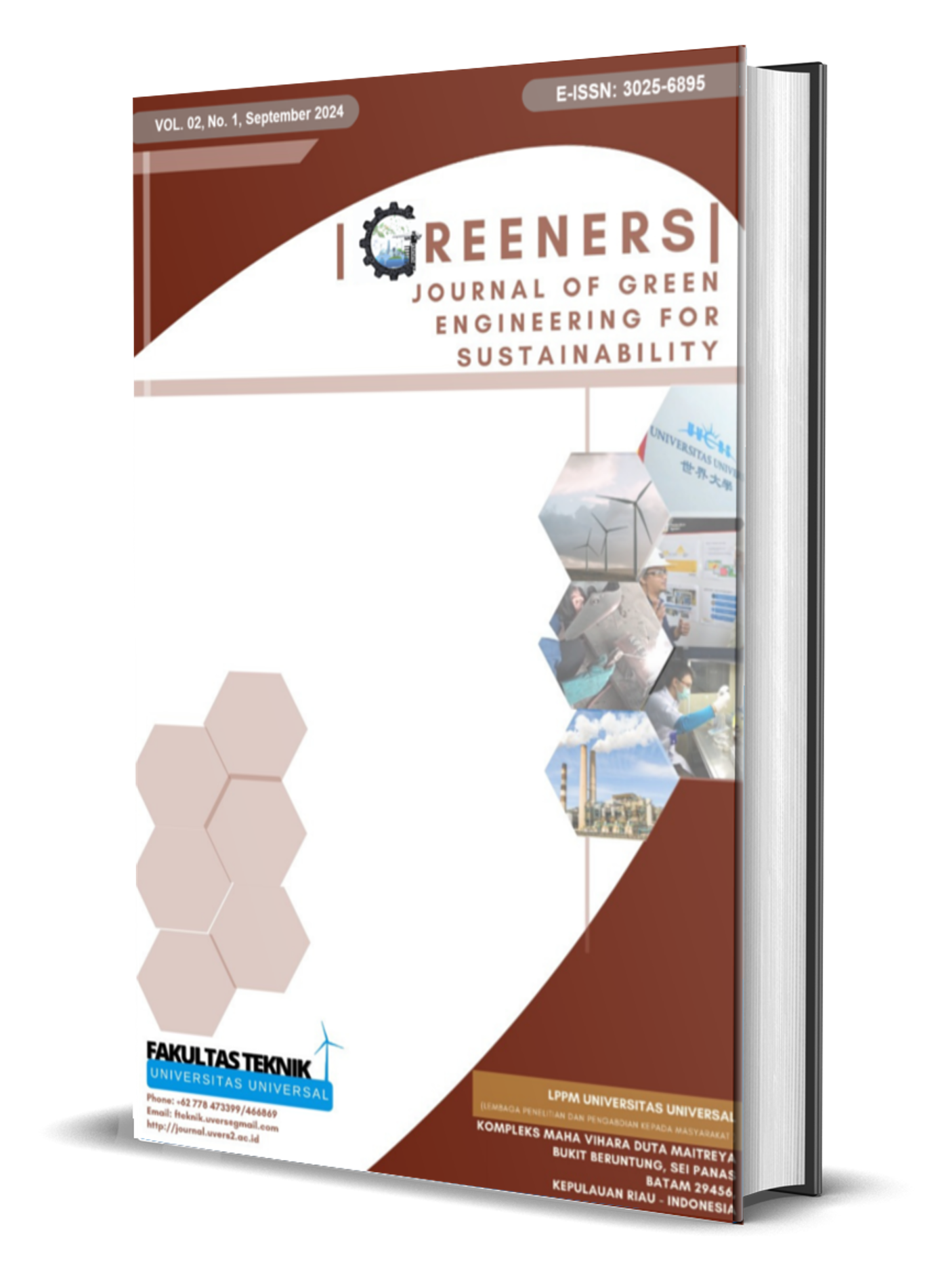An Analysis of the Implementation of Reverse Logistics to Improve Cost Efficiency in Medical Waste Management at Health Clinics
DOI:
https://doi.org/10.63643/jges.v3i1.301Keywords:
Reverse Logistics, Cost Efficiency, Medical Waste, Health ClinicAbstract
Medical waste management is a major challenge in the health system, especially in ensuring cost efficiency while minimizing environmental impacts. This study aims to analyze the relationship between the application of reverse logistics and the cost efficiency of medical waste management in health clinics. The methodology used is a quantitative approach with a sample of 36 respondents involved in medical waste management. Data was collected using a questionnaire and analyzed using the Chi-Square test to evaluate the relationship between variables. The research results show a significant relationship between the implementation of reverse logistics and cost efficiency, where better implementation can substantially reduce operational expenditure. The conclusions of this research indicate that medical waste management through reverse logistics effectively increases cost efficiency, and supports environmental sustainability. The practical implications of these findings can be a reference for health clinic managers in designing more efficient waste management strategies.
References
Dinas Kesehatan Kota Padang, Laporan tahunan pengelolaan limbah medis di Kota Padang. Padang: DKK Padang, 2022.
Kementerian Kesehatan Republik Indonesia (Kemenkes RI), Pedoman pengelolaan limbah medis fasilitas pelayanan kesehatan. Jakarta: Kementerian Kesehatan RI, 2021.
K. Hawks, “What is Reverse Logistics,” Reverse Logistics Magazine, 2016.
A. Ergülen, F. S. Özdemir, M. Gokmen, and Z. Ünal, “A Case Study of Recycle Based Reverse Logistics Cost Minimization,” J. Basic Appl. Res. Int., vol. 9, 2015.
F. Aini, “PENGELOLAAN SAMPAH MEDIS RUMAH SAKIT ATAU LIMBAH B3 (BAHAN BERACUN DAN BERBAHAYA) DI SUMATERA BARAT,” 2019.
A. M. Asrun, L. A. Sihombing, and Y. Nuraeni, “DAMPAK PENGELOLAAN SAMPAH MEDIS DIHUBUNGKAN DENGAN UNDANG-UNDANG No 36 TAHUN 2009 TENTANG KESEHATAN DAN UNDANG-UNDANG No. 32 TAHUN 2009 TENTANG PERLINDUNGAN DAN PENGELOLAAN LINGKUNGAN HIDUP,” 2020.
N. A. Foci, E. Amrina, and A. Hasan, “The Effect of Employee Engagement on Employee Performance in Private Agencies : The Moderation Influence of Employee ’ s Generational Characteristics,” vol. 13, no. 2, pp. 75–90, 2024.
T. O. Adesoga, O. P. Olaiya, E. P. Onuma, O. Ajayi, and O. D. Olagunju, “Review of reverse logistics practices and their impact on supply chain sustainability,” 2024.
T. K. Eltayeb, S. Zailani, and T. Ramayah, “Green supply chain initiatives among certified companies in Malaysia and environmental sustainability: Investigating the outcomes,” Resour. Conserv. Recycl., vol. 55, no. 5, pp. 495–506, 2011, doi: https://doi.org/10.1016/j.resconrec.2010.09.003.
S. Farisha and A. S. Putra, “Strategi Inovasi Semen Padang Hospital Dalam Peningkatan Produk Layanan Pada Masa Pandemi Covid-19,” vol. 6, no. 1, pp. 26–33, 2023.
D. S. Rogers and R. S. Tibben-Lembke, “An Examination of Reverse Logistics Practices,” Journal of Business Logistics, vol. 22, no. 2, pp. 129–148, 2001.
K. Govindan, M. Soleimani, and D. Kannan, “Reverse logistics and closed-loop supply chain: A comprehensive review to explore the future,” European Journal of Operational Research, vol. 240, no. 3, pp. 603–626, 2015.
T. McGain and C. Naylor, “Environmental sustainability in hospitals – a systematic review and research agenda,” Journal of Health Services Research & Policy, vol. 19, no. 4, pp. 245–252, 2014.
M. Zare, S. Maknoon, and M. H. Shirazi, “Integrated healthcare waste management model using life cycle assessment and multi-criteria decision making,” Waste Management, vol. 69, pp. 112–123, 2017.
B. S. Wilcox, “Cost-efficiency strategies in medical waste treatment,” International Journal of Health Economics, vol. 14, no. 2, pp. 122–131, 2015.
M. I. Salema, A. P. Barbosa-Póvoa, and A. Q. Novais, “An optimization model for the design of a capacitated multi-product reverse logistics network with uncertainty,” European Journal of Operational Research, vol. 179, no. 3, pp. 1063–1077, 2007.
A. K. Yadav, M. K. Tiwari, and R. Shankar, “Modeling the enablers of reverse logistics: A fuzzy DEMATEL approach,” Benchmarking: An International Journal, vol. 25, no. 5, pp. 1422–1444, 2018.
A. Ravi and R. Shankar, “Analysis of interactions among the barriers of reverse logistics,” Technological Forecasting and Social Change, vol. 72, no. 8, pp. 1011–1029, 2005.
S. Kumar and G. Dixit, “Evaluating the barriers of green and reverse logistics: a DEMATEL approach,” Procedia - Social and Behavioral Sciences, vol. 189, pp. 395–403, 2015.
M. A. Brown and e. al, "Energy efficiency: Technologies and policies," Annual Review of Environment and Resources, vol. 43, pp. 353-381, 2018.
P. H. Gleick, "The World's Water Volume 8: The Biennial Report on Freshwater Resources," Island Press, 2018.
Q. Zhu and et al., "The impact of institutional pressures on supplier development practices: Evidence from Chinese manufacturing firms.," International Journal of Production Economics, vol. 171, pp. 222-232, 2016.
B. Jacobs, "The impact of cross-functional integration on performance: The moderating role of climate for innovation," International Journal of Production Economics, vol. 205, pp. 168-177, 2018.
A. Prüss-Ustün and et al., "Safe management of wastes from health-care activities.," World Health Organization, 2019.
A. Kharrazi and et al., "Quantifying policies for sustainable urban environmental systems: An integrated environmental and economic assessment in Vienna," Sustainable Cities and Society, vol. 20, pp. 256-263, 2016.
M. Geissdoerfer and et al., "The circular economy – A new sustainability paradigm," Journal of Cleaner Production, vol. 143, pp. 757-768, 2017.
M. P. Wilson and B. L. Jones, "Chemical safety: International reference manual," in Springer, 2016.
F. Dahlmann and et al., "Corporate environmental strategy: Towards a framework for sustainable business," Business Strategy and the Environment, vol. 28, pp. 446-465, 2019.
S. Zhou and et al., "Health care waste management in Asia," a. International Journal of Environmental Research and Public Health, vol. 14, no. 11, p. 1472, 2017.
S. Yoon and J. Hwang, "Development of an integrated energy efficiency and greenhouse gas emission reduction strategy for medical facilities," Energy, vol. 149, pp. 341-352, 2018.
G. M. Kane and et al., "Circular economy solutions to close the loop on e-waste: A critical review," Journal of Cleaner Production, vol. 236, p. 117612, 2019.
J. A. Patterson and J. Patrick, "Medical equipment management in a developing economy: The case of Ghana," Global Health Action, vol. 10, no. 1, p. 1334590, 2017.
L. A. Y. Al-Hakim and C. Jin, "Performance evaluation of manufacturing industries: An integrated approach based on dynamic network DEA and neural networks," Journal of the Operational Research Society, vol. 1, no. 70, pp. 1-14, 2019.
B. T. Hazen, J. Huscroft, D. J. Hall, F. K. Weigel, and J. B. Hanna, “Reverse logistics information system success and the effect of motivation,” Int. J. Phys. Distrib. Logist. Manag., vol. 44, no. 3, pp. 201–220, Jan. 2014, doi: 10.1108/IJPDLM-11-2012-0329.
J. F. Hair, W. C. Black, B. J. Babin, and R. E. Anderson, Multivariate Data Analysis, 8th ed. Boston, MA: Cengage Learning, 2019.
Downloads
Published
How to Cite
Issue
Section
License
Copyright (c) 2025 Nia Arfina Foci, Rahmi M Nur, Syafira Salsabila, Muhamad Yasin, M Arif Munanda

This work is licensed under a Creative Commons Attribution-ShareAlike 4.0 International License.
















